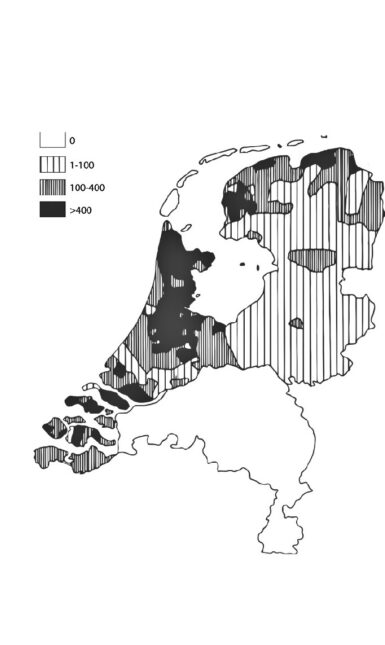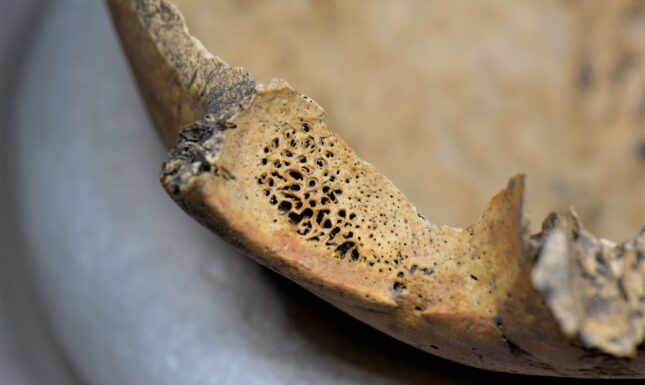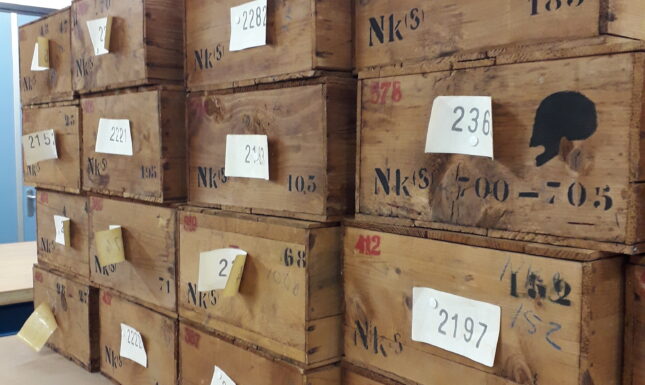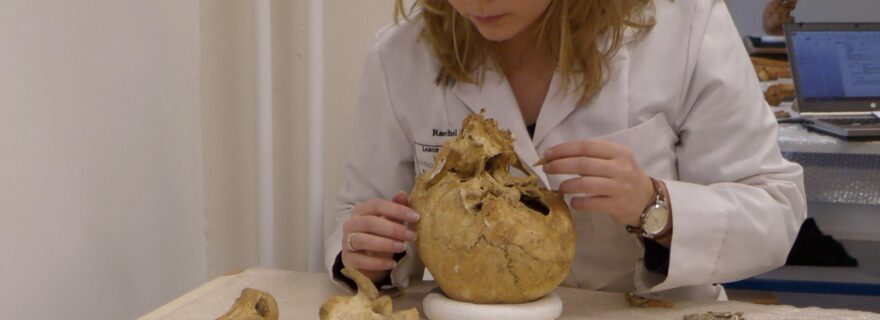Medieval Malaria: Skeletal evidence for this parasitic infection in the Netherlands
Malaria, a debilitating and often chronic disease, was a major health problem up to the 20th century in the Netherlands. But was this also the case for the medieval period?
Malaria in the Netherlands: a medieval disease?
Ziet ge muggen, lang van poot
Aarzel niet, maar sla ze dood!
Klein is de mug, maar groot het leed
Veroorzaakt door een muggebeet.
Beter dan chinine slikken,
Is het muggen dood te tikken!
Not many people know that malaria has a long history in the Netherlands. This short poem from the 1930s encouraging people to kill mosquitos was displayed in the offices of general practitioners (Van der Heide 1988) demonstrates that until very recently malaria was an impactful disease in the Netherlands. While currently mainly regarded as a tropical disease, references to symptoms which could be related to the disease are found in several historical documents from the 17th century onwards. Sylvius de la Boë, a Dutch doctor and anatomist, describes an epidemic of fevers in Leiden in 1669 and the famous Dutch physician Herman Boerhaave also has written extensively about the fevers causing many deaths in The Netherlands (Bruce-Chwatt and Zuleta 1980). In 1826, a severe outbreak of fevers, apparently related to flooding of the North-Sea, caused many deaths. In Amsterdam for example, 2400 of the 200,000 inhabitants are reported to have died as a result of ‘malarial disease’. Several more outbreaks would plague the Netherlands in this century (Bruce-Chwatt and Zuleta 1980), although the infection rates became somewhat lower in this time. This was most likely as a result of the increased availability and reduced price of the medicine quinine (Van Seventer and De Buck 1938).
What is clear throughout time is the relationship between marshy areas, especially regions that were reclaimed from the sea, and the prevalence of malaria. The current provinces of Zeeland, Friesland, North-Holland, and Groningen appear to have been most heavily affected (Bruce-Chwatt and de Zulueta 1980) (see fig. 1). In the 20thcentury, it became clear that this is a result of the preference of Anopheles atroparvus, the mosquito species which was transmitting malaria in the Netherlands, for breeding in brackish water. In the peat and clay areas, water salinity would have been high, creating the perfect breeding ground for malaria mosquitos.

While it is expected that the disease was also present in the medieval Netherlands, the lack of solid documentation impairs the assessment of the impact and spread of malaria during this time. Because of this, the disease is only rarely included in discussions on medieval health, leaving us with an incomplete and potentially flawed understanding of the well-being of past societies. Research on medieval Cambridge by Prof. John Robb (Cambridge University) has shown that while the Black Death was a hugely influential medieval disease, the impact of the more chronic diseases like malaria, plaguing the lives of past people on a daily basis, should not be underestimated. While associated with lower levels of mortality, clinical studies on the Dutch malaria type, caused by the Plasmodium vivax parasite, demonstrate that “every person in a moderately P. vivax-endemic area can expect to experience anywhere from 10 to 30 or more episodes of malaria in the course of childhood and working life” (Mendis et al. 2001, 101). With each episode lasting up to 15 days and confining the patient to their bed, this disease can therefore have far-reaching social and economic consequences. Since the medieval environmental circumstances, particularly in the coastal regions with its abundance of brackish water, would have created the perfect breeding ground for the mosquito (Jetten and Takken 1994), malaria could have been a health problem of epidemic proportions. Gaining a better understanding of medieval malaria is therefore essential.
Malaria in the skeleton
While the paucity of historic documentation has thus far limited the possibilities to study medieval malaria, recent developments in osteoarchaeology, the study of archaeological human skeletal remains, allow for an assessment of the disease in skeletal remains. Unfortunately for archaeologists, malaria does not result in definitive lesions in the skeleton, but several studies suggest that a skeletal indicator of anaemia, termed cribra orbitalia (fig. 2), can be used as a marker for the disease in the archaeological record (Gowland and Western 2012; Schats 2015; Smith-Guzmán 2015). Anaemia is one of the most of the important symptoms of a malaria infection and there appears to be a strong correlation between this porous lesion in the orbits and malaria. Gowland and Western (2012) convincingly showed that there is a clear link between mosquito presence, certain geographical factors like brackish water, and cribra orbitalia in the Anglo-Saxon UK (Gowland and Western 2012).

If malaria was a also a problem in the medieval Netherlands, we would expect to find a similar correlation between the skeletal lesion cribra orbitalia and the marshy, brackish Dutch provinces. To test this, a pilot study, focusing on published archaeological skeletal data, has looked at the prevalence of cribra orbitalia and the relation to find location in 13 sites and found that this indicator for anaemia was statistically significantly more common in the coastal areas of the Netherlands (Schats 2015). While this study was based on data collected by other researchers and used a modest sample size and limited geographical spread, the results tentatively suggesting that malaria was also an important medieval disease, at least in certain regions of the country.
Mapping Medieval Malaria: a comprehensive study
To be able to better understand this disease and its impact in the medieval period, a larger study with good geographical spread across the Netherlands is necessary. This is what the current NWO funded project aims to do. A total of 30 skeletal collections will be studied in various archaeological depots (fig. 3) in the Netherlands and data on age-at-death and sex will be collected. So far, just over 1300 individuals have been analysed. Preliminary results show that the skeletal marker for anaemia is more common in the coastal areas, like for example Zeeland and North-Holland, which may confirm the patterns found in the earlier study. Interestingly, children especially appear to be very frequently affected by anaemia which may suggest that they were particularly vulnerable, as is still the case today. Although more work needs to be done, this research into archaeological skeletons from the medieval period will allow for a better understanding of malaria and its societal impact leading more complete and refined interpretations of medieval health and society that would be very difficult to obtain through other means. To be continued!

Further reading
Bruce-Chwatt, L.J. and J. de Zulueta (1980). The Rise and Fall of Malaria in Europe: A Historico-Epidemiological Study, Oxford
Gowland, R.L. and A.G. Western (2012). Morbidity in the marshes: Using spatial epidemiology to investigate skeletal evidence for malaria in Anglo-Saxon England (AD 410-1050). American Journal of Physical Anthropology 147(2), 301-311
Jetten, T.H and W. Takken (1994). Anophelism without malaria in Europe. Wageningen Agricultural University Papers 94(5), 1-61
Mendis, K., B. Sina, P. Marchesini and R. Carter (2001). The neglected burden of Plasmodium vivax malaria. The American Journal of Tropical Medicine and Hygiene64(1_suppl), 97–106
Schats, R. (2015). Malaise and mosquitos: Osteoarchaeological evidence for malaria in the medieval Netherlands. Analecta Preahistorica Leidensia 45,133-140
Smith-Guzmán, N.E. (2015). The skeletal manifestation of malaria: An epidemiological approach using documented skeletal collections. American Journal of Physical Anthropology158(4), 624–635
Soren, D. (2003). Can archaeologists excavate evidence of malaria? World Archaeology35(2), 193–209
Stuart-Macadam, P. 1991. Anaemia in Roman Britain. In Health in past societies. Biocultural interpretations of human remains in archaeological contexts. H. Bush and M. Zvelebil (eds.). British Archaeological Reports 567, 101-113
Swellengrebel, N.H. and A. de Buck (1938). Malaria in The Netherlands. Scheltema & Holkema, Amsterdam.
© Rachel Schats and Leiden Medievalists Blog, 2021. Unauthorised use and/or duplication of this material without express and written permission from this site’s author and/or owner is strictly prohibited. Excerpts and links may be used, provided that full and clear credit is given to Rachel Schats and Leiden Medievalists Blog with appropriate and specific direction to the original content.


